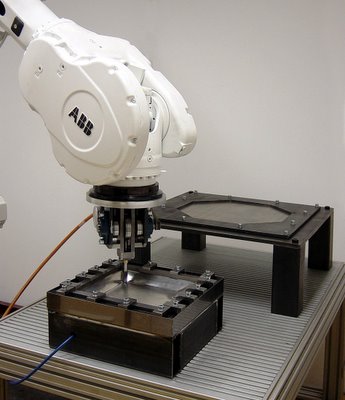No one's even sure what to call it. "Claytronics," "synthetic reality" and "programmable matter" have been proposed. "Dynamic physical rendering" is the label Intel uses.
"I'm still working on my 'elevator pitch,' " said
Randy Bryant, dean of the
Carnegie Mellon School of Computer Science, noting he struggles to find a quick way to describe it to potential sponsors. The
National Science Foundation and the
Defense Advanced Research Projects Agency have provided some funding thus far.
...a big pile of beads. Or the beads might reassemble into a piece of moving sculpture, or turn into a chair.
"I don't think 3-D TV is out of the question, either," said
Seth Goldstein, a computer scientist at Carnegie Mellon University who is trying to figure out how to use, build and control these amalgams of tiny robots.
Building a moving, sensing, color-changing replica of each person out of nanotech robots seemed a possible answer. "Every meeting would be a face-to-face meeting."
He and Goldstein have even come up with a name for this new media, a successor to audio and video that they call "pario."

Interacting with a faintly glowing replica of a person might seem a little creepy, Bryant admitted. Then again, "I'm sure people of 200 years ago would be pretty creeped out if you told them about radio and television."
Each of the individual robots comprising people or shapes would be a "claytronic atom," or catom. Likely spherical in shape, a catom would have no moving parts. Rather, it would be covered with electromagnets to attach itself to other catoms; it would move by using the electromagnets to roll itself over other catoms.
The catoms' surfaces would have light-emitting diodes to allow them to change color and photo cells to sense light, allowing the collective robot to see. Each would contain a fairly powerful, Pentium-class computer.
For now, the researchers are trying to build a two-dimensional version, with each catom being a cylindrical device a little more than an inch in diameter with its side encircled by 24 electromagnets.
 2D Catoms
2D Catoms Eventually, they hope to build enough two-dimensional catoms to begin experiments with shape changing. Next, they plan to build as many as 100 Ping-Pong-ball-size robots that could move in three dimensions.
Goldstein said building smaller marble-size catoms and, ultimately, one-millimeter diameter catoms will be hard, but "sort of inevitable." So much of their research effort is focused on how to power and control so many catoms.
A large, moving shape such as a human replica might contain a billion catoms, Mowry said. A system with a billion computer nodes, he added, "is something on the scale of the entire Internet. . . . Unlike the real Internet, our thing is moving."
Even if claytronics doesn't immediately yield 3-D motion, it might be useful for producing 3-D shapes in the computer-aided design process, Goldstein said. Claytronics antennas could change shape to improve reception of different radio frequencies. A Claytronics cell phone might grow a full-size keyboard, or expand its video display as needed.
Claytronics Home'Programmable matter' one day could transform itself into all kinds of look-alikes












